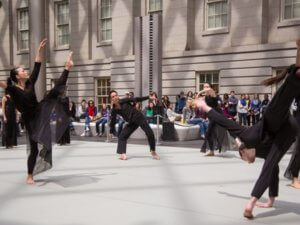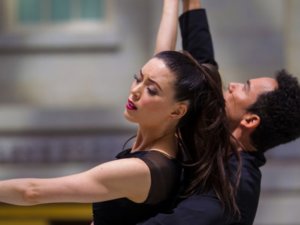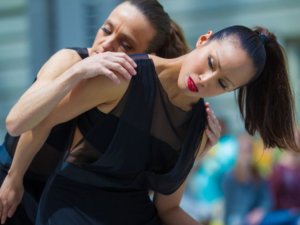
Doris Humphrey, by Barbara Morgan, 1938
Under the floating roof of the National Portrait Gallery, old and new fans of Washington DC’s preeminent dance company, Dana Tai Soon Burgess (DTSB), were treated to a new piece, “Confluence,” once again inspired by the on-going show, “Dance the Dream.” For this piece, Burgess took his inspiration from the moody 1938 portrait of modern dance pioneer Doris Humphrey by Barbara Morgan.
 Fraught with psychological overtones, the image led Burgess to make this new dance expressing “an emotional terrain of the mind” whose predominant theme is the uncomfortable state brought about by short meetings—trysts—in which feelings are unresolved.
Fraught with psychological overtones, the image led Burgess to make this new dance expressing “an emotional terrain of the mind” whose predominant theme is the uncomfortable state brought about by short meetings—trysts—in which feelings are unresolved.
Ten dancers enter from “off stage,” elegant in Judy Hansen’s black costumes, and walk with great ceremony to stand at the far edge of the performance space. In silence, one of the figures swoops away from the others, then another, and another, until they’re briefly united, circling a spot at their feet. When the opening notes of Ernest Bloch’s “Hebraic Suite” breaks the silence, the viewer is swept away. Divided into four movements that flow into one another seamlessly, the sense of portent is palpable from the outset.
 In this piece, Burgess’s characteristic spare, clean lines are punctuated with sharp, pecking arm and hand gestures, and an idiosyncratic pulling motion that seems to draw an invisible thread from inert figures on the floor. Fluid, organic movements mingle and merge in hypnotic ways, the dancer’s faces showing more and more eye contact and emotion—ranging from wariness to openness to outright fear—as the dance progresses. This churning intensity propels the dancers upward into spectacular lifts and downward into curled resting positions. Twice, male dancers lift women and hold them aloft, straight as exclamation points, like “pillars of emotion,” to use Burgess’ words.
In this piece, Burgess’s characteristic spare, clean lines are punctuated with sharp, pecking arm and hand gestures, and an idiosyncratic pulling motion that seems to draw an invisible thread from inert figures on the floor. Fluid, organic movements mingle and merge in hypnotic ways, the dancer’s faces showing more and more eye contact and emotion—ranging from wariness to openness to outright fear—as the dance progresses. This churning intensity propels the dancers upward into spectacular lifts and downward into curled resting positions. Twice, male dancers lift women and hold them aloft, straight as exclamation points, like “pillars of emotion,” to use Burgess’ words.
 While exploring the uncertainty of short relationships that “are not love, not trusting,” the dance shows us the various effects of touch—it can soothe and it can hurt. Hands caress, appear to strike, swoop in crane-like arches, and, in staccato bursts, express frustration and tension between partners. Dancers also leaned their heads on their partner’s shoulders, backs, and arms, allowing momentary respite from the mood of suspended anxiety and bringing a fleeting sweetness into the mix. Not that this sustained emotion is hard to watch. Quite the contrary. It would have been impossible to look away.
While exploring the uncertainty of short relationships that “are not love, not trusting,” the dance shows us the various effects of touch—it can soothe and it can hurt. Hands caress, appear to strike, swoop in crane-like arches, and, in staccato bursts, express frustration and tension between partners. Dancers also leaned their heads on their partner’s shoulders, backs, and arms, allowing momentary respite from the mood of suspended anxiety and bringing a fleeting sweetness into the mix. Not that this sustained emotion is hard to watch. Quite the contrary. It would have been impossible to look away.
 The complex choreography, seemingly propelled by the swirling, eddying music, conjures bodies of water meeting, joining and flowing in sometimes gentle and sometimes turbulent ways. I was particularly struck by the complex whorl of movement in which the woman lifted the man, and another pairing in which the woman rolls her head and upper body along the outstretched arm of the man. The work is filled with many such strikingly original moments.
The complex choreography, seemingly propelled by the swirling, eddying music, conjures bodies of water meeting, joining and flowing in sometimes gentle and sometimes turbulent ways. I was particularly struck by the complex whorl of movement in which the woman lifted the man, and another pairing in which the woman rolls her head and upper body along the outstretched arm of the man. The work is filled with many such strikingly original moments.
 “Confluence” ends with a woman placing her hand on a fallen man’s body. Her expression is unreadable—does she feel victorious, dominant, or tender? It’s a moving end to a piece in which the viewer is pulled into a darkly absorbing psychological space. Doris Humphrey would have loved it!
“Confluence” ends with a woman placing her hand on a fallen man’s body. Her expression is unreadable—does she feel victorious, dominant, or tender? It’s a moving end to a piece in which the viewer is pulled into a darkly absorbing psychological space. Doris Humphrey would have loved it!
Being able to see such exquisite work in such a fabulous setting is a privilege and a gift. We who are DTSB fans look forward to seeing this new piece performed in a traditional setting. If you’re not familiar with this treasure of a dance company, do visit their website at http://dtsbdc.org/ and make a point to see an up-coming performance. To echo, Amy Henderson, the adventurous curator of “Dancing the Dream,” you can’t have a static museum show about dance. We hope this exciting collaboration between museum and choreographer-in-residence will endure and flourish.
 And, if you haven’t seen it yet, “Dancing the Dream” is on view in the National Portrait Gallery until July 13, 2014. http://www.npg.si.edu/exhibit/exhdance.html
And, if you haven’t seen it yet, “Dancing the Dream” is on view in the National Portrait Gallery until July 13, 2014. http://www.npg.si.edu/exhibit/exhdance.html
Photos by Jeffrey Malet of WUSA/Channel 9










